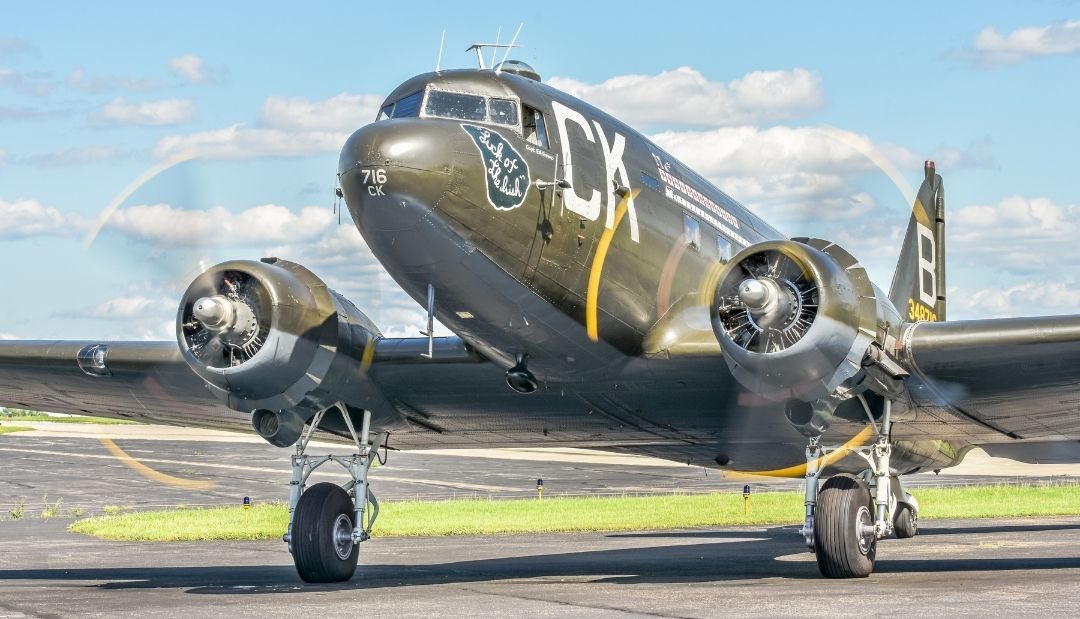Photography by: Brad Verlihay | 724-494-6902 | verlihayb@gmail.com
When we learn about history, we usually learn about the ‘big picture’; the key players and major events. We don’t always learn about the moments and individuals whose benefit to the public didn’t make public eye. The ‘small’ stories of history, (though hardly of small significance), don’t always receive recognition.
Sometimes, though, they do, and you needn’t look beyond Chippewa to find an example of this.
At our local Air Heritage Museum, a Douglas C-47B Skytrain [known as Luck of the Irish (LOTI)] is under restoration. Already, the once faded exterior of this retired military aircraft looks like a “snapshot” of her first flight to Europe during WWII. That is according to museum volunteer Dave Messersmith, who helps organize the work on LOTI.
The aircraft’s interior is now the main focus of restorative work. Here too, Dave says the aim of the project is for LOTI to mirror her past self. She will not be made to look like another, ‘more famous’ aircraft, although that has been the outcome of some restorations elsewhere.
No, LOTI will be restored to original condition, so as to honor the history that she – and no other aircraft – represents. While the story of this C-47B and her crew may not be in the greater public eye (yet), it is most certainly deserving of our recognition.
The story begins in 1944 Oklahoma City, OK, when and where LOTI was built by a Douglas Aircraft Company plant. From there, LOTI was delivered to the US Army Air Force (the Air Force was not a branch apart from the Army until 1947), whose involvement in WWII had begun just three years prior.
She was assigned to Captain Edward “Elmo” Frome of the 75th Troop Carrier Squad, at which point LOTI received her name, Luck of the Irish. While in the 75th, LOTI flew on several missions over Europe – at least 96, according to records obtained by the Air Heritage Museum.
A few of LOTI’s most notable missions occurred during the Battle of the Bulge, which began on December 16, 1944. On that day, German forces stormed a large group of Allied troops in Belgium. Allies dug in at the city of Bastogne, but rations, clothing, and other critical supplies were running low.
Thankfully, provisions were replenished on December 23rd, 24th, and 26th, when several squadrons, (including the 75th), dropped supplies in parapacks over the city. LOTI participated in the December 24th and 26th supply runs, aiding the Allied victory that was won on January 25, 1945; a victory that marks the end of all German assaults on the western front.
LOTI also participated in Operation Varsity on March 24, 1945. This operation represents the largest air drop of soldiers and supplies in a single day, to date. Drops were made over designated landing zones in Germany, from which supplies were distributed or soldiers marched out.
Cpt. Frome, in his C-47B, toted two Waco CG-4A gliders occupied by soldiers. He released these and returned to the airfield. Meanwhile, back in enemy territory, the fallout of Operation Varsity was shaping out to be a key factor for success in our final push into Germany.
And when Germany surrendered on May 8, 1945, LOTI was one of three aircrafts sent to deliver the “Stars and Stripes, Victory Edition” to airfields in Europe. “Stars and Stripes” was (and is) a US military magazine that kept soldiers informed of major events in the war. The victory edition, of course, would have told them that the war had ended.
LOTI’s work with the 75th ended a few weeks later, on May 25th. That day, she flew her last WWII mission, evacuating POWs. The 75th, for its part, was inactivated on November 15, 1945. Members of the 75th were given other roles within the US Army, and so was LOTI.
The US Army Air Force, and later the US Air Force, utilized LOTI in various capacities until 1974. Technology had advanced past the C-47B design by this point, and so LOTI was placed in storage that November.
She remained there for six months before the state of Florida acquired her, painted over the military insignia, and modified the C-47B for mosquito spraying. Florida State (and, more broadly, the US Department of Health) owned LOTI until the Vietnam Huey Pilots Association Museum bought her in 2012. And in 2013, after some negotiation, the Air Heritage Museum bought her from them.
At the time, Air Heritage was unaware of LOTI’s history in WWII. But after a little digging, the museum was able to discover the aircraft’s origins, squadron assignment, and the identity of her pilot, Cpt. Frome.
Museum volunteers were able to connect with Cpt. Frome and learn additional details about the aircraft’s history from him. They maintained a connection with the veteran until his passing later in 2013, and since then have remained in contact with the Frome family.
Once Air Heritage had learned the full story of LOTI, restoration began with the help of many volunteers. The aircraft needed a number of repairs and touch-ups where she was showing age or had been modified, so there was much work to be done.
Part way through the work, Air Heritage had the chance to give Cpt. Frome’s daughter a tour of the C-47B. She was able to look over LOTI and even assume the captain’s seat. The aircraft wasn’t ready for a take-off that day, but all present could imagine Cpt. Frome – sitting in the very seat his daughter now occupied, piloting LOTI down a runway in Europe.
It was a powerful and touching scene, says Dave, worthy of “alligator tears.”
Following that unforgettable tour, restoration work continued. In 2018, LOTI was ready for her first test flight at the museum. More flights were to follow the first, and volunteers began flying LOTI at airshows in 2019.
These aviation events often involve WWII battle reenactments, where actors play soldiers on the ground and aircrafts zoom by overhead. And when participating aircrafts aren’t in the sky, they’re frequently set up as ‘static displays.’ That allows show goers to learn the aircrafts’ stories, as well as the ‘big picture’ history of WWII.
Airshows also allow us to see LOTI in a new light; in her most recent role of many since 1944. At these aerial events – and really, everywhere she goes – LOTI is serving her country, in Dave’s words, as “a flying memorial.”
If you’d like to learn more about LOTI, her history, and the history of many other aircrafts, you can visit the Air Heritage Museum on the Beaver County Airport Aviation Campus. Admission to the museum is free.







